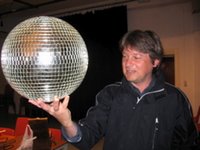Scrapyard Challenge

Run by Katherine Moriwaki and Jonah Brucker-Cohen
Steim, Amsterdam, 21 June 2006
many pictures can found here
A brilliant day at the Scrapyard Challenge, led by Katherine Moriwaki and Jonah…a day which at first appeared totally scary, faced by tables of geeky wires, sensors, motors etc, plus soldering tables and controllers with a guy on midi there too. However, the promise that ‘drawbots’ would break down the barriers for all of us was well founded – by half past ten I’d built my first ‘robot’ which did in fact draw. OK, it used agitation and an off-centre weight to create motion, but as soon as these principles became tangible, people became engrossed in extending their application, connecting motors and appendages in new ways for different movement, attaching them to flexible rulers, with pens at the horizontal, and so on. I tried to get a lovely mechanical three pronged whisk to rotate with my motor – even adding an extra one, then two, to power the individual shafts, but really the mechanical resistance was too great for the motors we had – to be continued...
I couldn’t let the day go by without making the most of especially Katherine’s expertise in the use of conductive textiles, and right enough, it was simple to very quickly put together an ‘instrument’ for one or two bodies, comprising four separate channels and the switch – that is, four strands of fabric, each with its own wire connection (to 5V), and a sleeve piece which could ‘strum’ them, producing individual chords and notes. Worn by two people, it became a self-defence mechanism, a blocking device, with movement implied by the form of the piece. Worn by one person, it was more ‘intimate’, an itch to be scratched – not a comfortable looking interaction.

Also tried to make a piece with knots using different quantities of conductive thread, the idea being that a knot of four times the size of another would produce a note resulting from a comparatively increased resistance. It didn’t work, but the fault may have been in the midi processing rather than elsewhere. It did, however, create a variable resistor, and so gave a nice pitch bend. Each knot gave the same pitch bend (on the same note), but the larger one felt better to use as an interface.
Interestingly, the workshop illustrated the craft aspects of electronic and physical computing design, in that it was often to a great extent materials led. Forms existing in objects, and discoveries of functionality and principle led to innovative and creative juxtapositions of form, interaction and output. No-one began with a high level concept and looked for the best technology to realise it. There was a kind of brainstorming through materials, an iteration with interaction possibilities, and also a potential process for further work, beyond the ‘lash-up’. These seem to have a strong resonance with craft characteristics – exploration and workmanship?

Many participants talked about the value of the playfulness of the event as opposed to planned design projects, whether for university modules or in search of funding. Particularly, the opportunity to ask ‘dumb’ questions in a supportive environment was highly valued, especially as the response would be hands on rather than abstract, and this coupled with the non-precious nature of the approach meant that mistakes could be learnt from with impunity.
